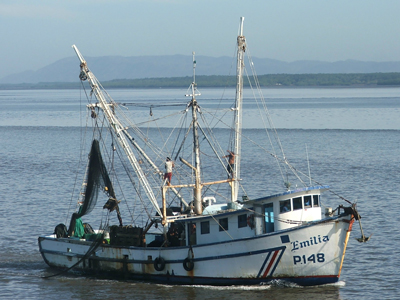REBYC II-LAC project starts a research phase and tests of Bycatch Reduction Devices in the Golf of Nicoya, Costa Rica
- REBYC will conduct the first tests with bycatch reduction devices (BRD) to understand their impact on catch composition in Costa Rican bottom trawl fisheries.
- Vessels from Puntarenas will participate in the research that is being carried out in a transparent, shared and participatory process.
Puntarenas, July 26th, 2017. Fishers, fish workers and their families involved in the bottom trawl shrimp fishery of the Pacific Coast of Costa Rica continue working to achieve a responsible fishery and comply with the order of the country’s constitutional court, that demanded that the fishery become sustainable.
Officials from the Costa Rican Institute of Fisheries and Aquaculture (INCOPESCA) and vessel crews met to agree on the methodology of the studies that will determine the effectiveness of the use of the “fish-eye” fish exclusion device currently in use. This research will quantify what impact, if any, the device has on the bycatch associated with two specific species of shrimp: the Fidel (S. agassizii) and the pink, also known as pinky (F. brevirostris) and will be based on principles of shared, participatory and transparent research.
 |
The research is being conducted with support from the Regional FAO project on the Sustainable Management of Bycatch Latin America and Caribbean of Bottom Trawl Fisheries (REBYC II-LAC), which aims to achieve responsible trawling and mitigate its impact on the environment.
The "fish eye" is a metal structure in the form of an eye, which is installed in the trawl in a position prior to the cod-end (end of the bag where the catch is located) and allows escape of the marine species that are not the target fish so that they can return calmly to their habitat.
As a methodology for the baseline studies, at least 30 hauls shall be made under conditions of usual fishing operations from an active vessel. In the vessel, one net will go with the BRD device and another one without it, to demonstrate statistically the differences that the use of these devices produces. In addition to the "fish eye", trials of other fish-reducing devices that have been successful across the world.
The researchers and crew members hope to quantitatively asses the obligatory and effective use of the device to achieve a more productive and sustainable fishing.
"This test is important for us because it will allow us to define the convenience of using this device in semi-industrial trawlers," said Isaac Baldizón, a consultant biologist for the REBYC-II LAC project.
To determine this process, part of the crew of semi-industrial trawlers Captain Moreno, Freyman, San Luis, Sonia, and Pingüino gathered at the INCOPESCA facility in Puntarenas where they met with Biologist Bernal Pacheco of INCOPESCA's Research Department, other members of the Puntarenas Fishermen's Chamber (CAMAPUN), Mr Baldizón, the INCOPESCA project focal, Víctor Fernández and the national project coordinator, Ana Lucrecia Barrantes.
